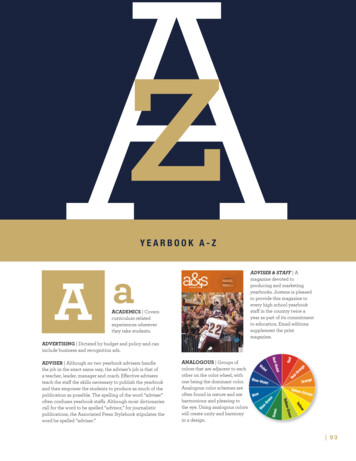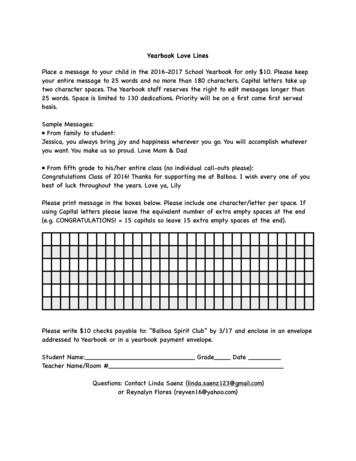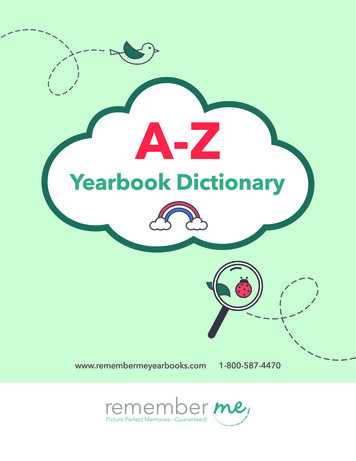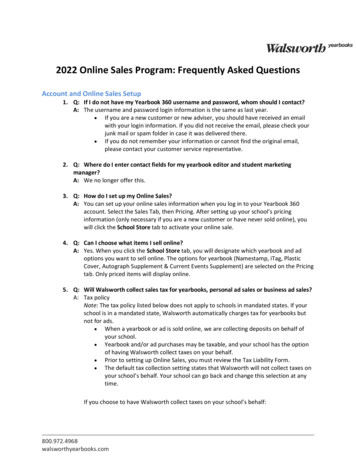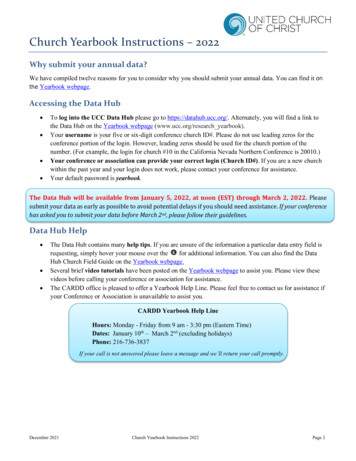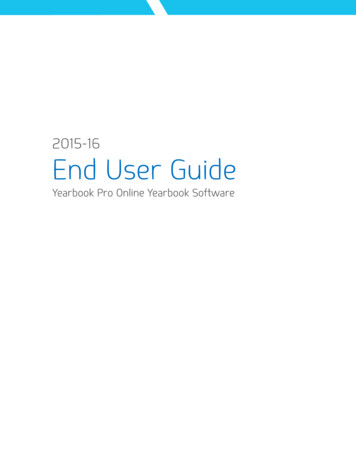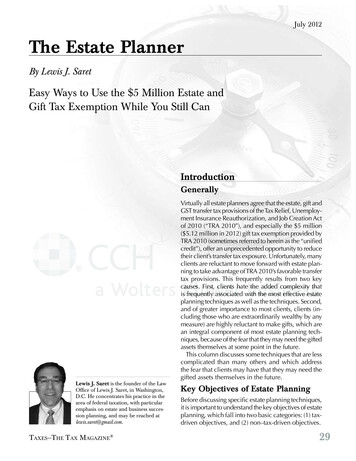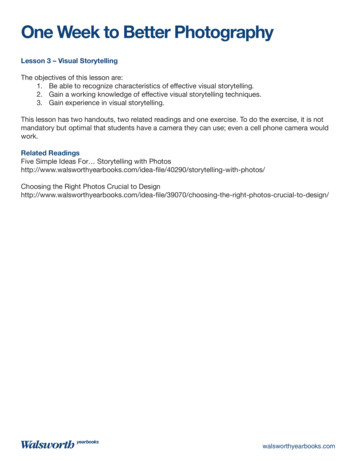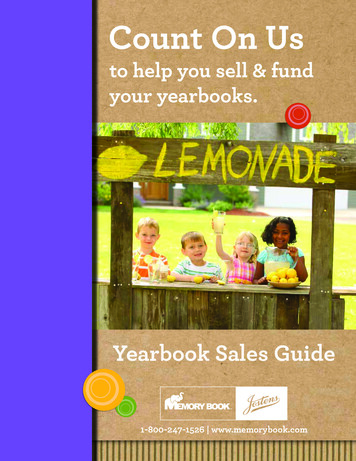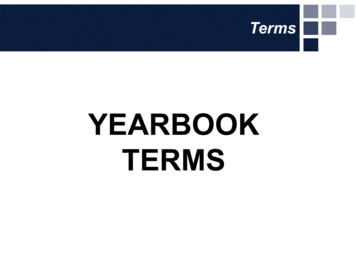
Transcription
TermsYEARBOOKTERMS
Yearbook ComponentsYearbook BasicsSections of the BookTheme & Incorporating Your Theme
YEARBOOK BASICSThe yearbook is printed in 16-page mini-booklets. Each signature (mini-booklet) begins as a giantsheet of paper with eight pages printed on eachside, called a multiple. After the sheet is printed on both sides, it is foldedinto booklet form and trimmed, forming 16consecutive pages.
YEARBOOK BASICSMultiple 1 - Pages are printed as seen below on one side of the sheetof paper.Multiple 2 - Pages are printed as seen below on the other side of thesheet of paper.Once all pages have been printed, the paper is folded and cut, forming16 consecutive pages called a signature.Multiple 1Notice: The pages are not printed consecutively and the top of eachpage faces the center fold of the sheet of paper.
YEARBOOK BASICSWhat is a Ladder? Page-by-page planner and deadline tracker used to identifycontent, record deadlines, plan color placement and trackpages submitted and proofed. The ladder is organized by spreads, multiples and signatures. The ladder should be completed before yearbookproduction begins. Efficient to use a paper ladder (located in your yearbook kit)and an electronic, editable ladder.
YEARBOOK BASICSMore than just a Cover The cover presents the year’s unique themeshowcasing fonts, colors and graphics that will beused inside the book. The cover consists of the front lid, the back lidand the spine/backbone.
YEARBOOK BASICSEndsheet The heavy paper between the cover and the first andlast pages is used to hold the signatures inthe yearbook. Endsheets can be designed by the staff tocomplement the cover.
YEARBOOK BASICSCoverCastle View High School / CO
YEARBOOK BASICSEndSheetRocklin High School / CA
YEARBOOK BASICSDEFINTIONSDouble Page Spread (DPS): Two facing pages telling a story.Page: A single page of content with the opposite page featuring adifferent, yet often related topic.Page Numbers: Also called folio or folio tabs, they provide specificquick references for readers. Ex: “Page 26 - Varsity Football.”Byline: The name of the author(s) of the spread/page/mod. Canbe added to the end of the feature story or as part of the folio.Content Module (or Mod): Portion of a page/spread containing amini-design of photos/text; can be displayed with other contentmodules to present different angles on the same topic.
YEARBOOK BASICSTraditional Coverage includes the following sections:Title Page, Table of Contents, and Opening Consider placing the table of contents on the endsheet ortitle page (page 1). Also, this would be a good place to putthe school information and theme (page 1).Sports Section Highlights the athletic events of your schoolAcademics Section Should highlight the exciting and interesting things going onin the classroom.
SECTIONS OF THE BOOKTraditionalClubs/Organizations Section: Records thehappenings of the clubs that exist in your school(school sponsored and student sponsored).People Section: School “mug shots” of allstudents and staff in the school.Student Life Section: Highlights activities thattake place in the lives of students in and outsideof school.
SECTIONS OF THE BOOKSportsDel Oro High School / CA
SECTIONS OF THE BOOKStudent LifeDos Pueblos High School / CA
SECTIONS OF THE BOOKOrganizationsAlpharetta High School / GA
SECTIONS OF THE BOOKPeopleCoppell High School / TX
SECTIONS OF THE BOOKChronologicalChronological yearbooks: One that progresses throughtime, rather than the traditional sections of People,Academics, Organizations, Student Life, Sports and Ads, cantake several forms. The book can be structured by seasons, months, weeks ordays. One of the biggest advantages is that it is easier to meetdeadlines because the yearbook staff is taking photos,gathering stories and creating spreads as events unfold.
SECTIONS OF THE BOOKTraditional AND ChronologicalAdvertising/Community Section Used as a fundraiser, personal (or recognition) ads are created by familymembers to celebrate their graduating student. Other options includefriendship, accomplishments, etc. Also used as a fundraiser, business (or patron) ads are sold byyearbook staff members and allow local businesses to advertise in thebook.Reference Section Athletic team shots and club group shots (with names) can be placed inthe back of the book to save space on content spreads.Index A record of who is in the book and where the reader can find them. Caninclude photos for more coverage.
SECTIONS OF THE BOOKAdvertisementsOrono High School / MN
SECTIONS OF THE BOOKReferenceGrand Blanc High School / MI
SECTIONS OF THE BOOKIndexAndover Middle School / KS
THEMETheme: A central idea or concept that sets the tone fortelling the story of the year. Repeated throughout theyearbook on cover, endsheets, opening, closing anddividers, it unifies the storytelling message of the book andgives it personality.How to incorporate your theme into the book:LogoColorGraphicTypography
INCORPORATING YOUR THEMEWays to incorporate the theme in your book:Logo Choose type styles and a design that convey the meaning, tone and style of thetheme. In the design, emphasize a key word or phrase. For example, in thetheme “On the Move,” you could set the word “move” in large italicized type toimply motion.Colors Repeat colors introduced on the cover throughout the book. Take advantage ofobvious color opportunities in themes such as “Out of the Blue.”Graphics Lines, tints, screens and textures can help emphasize specific areas withindesigns.Typography Use selected fonts only to enhance the theme. Body copy should be simple andreadable.
INCORPORATING YOUR THEMEOpeningGives anintroductionto your themeand startsthe book outon that note.ClosingDividersFinishes thestory of theyear andbrings thebook closure.Pages/spreadsthat indicatenew sectionsand providecontinuitywith yourtheme.
SECTIONS OF THE BOOKOpeningGreen Valley High School / NV
SECTIONS OF THE BOOKDividerIdaho Falls High School / ID
Putting it TogetherWriting ElementsDesign ElementsPhotography Elements
WRITING ELEMENTSHeadline Introduces the reader to the page by summarizing the story ofthe page or highlighting its focus. Should use literary devices tobe clever or eye-catching.Subheadline Accompanies the primary headline. It is short and catchy, andoffers specific information and added details about the storysubject.Feature Story Usually 3-5 paragraphs, a feature story tells about the eventand gives more insight and detail than a caption can. It is atraditional method of telling about an event.
HEADLINESAlliterationSubheadlinePlay onWordsWestlake High School / TXFeatureStory
WRITING ELEMENTSCaption: tells the reader more about the photo than theycan simply see. There are 4 main types of captions:Indent Captions simply identify the subject of the photo withtheir name and grade.Summary Captions are 1-2 sentences and provide more information notvisible in the photo.Expanded Quotes can be added to a summary caption to createan expanded caption.Group Group captions are for sports and club team shots to identifythe subjects of the photos left to right, bottom row to top row.
CAPTIONCaptionBryant High School / AR
WRITING ELEMENTSQuick Reads/Infographics: Offer the reader (and yearbook staffer) adifferent way to view information on a yearbook spread.They’re often packaged with graphics. Examples include: Figures: table, index, listing, stats, chart, scoreboard, pie chart Facts: fact box, listing, top 10, summary points, informational map,diagram, definitions, profile Opinions: quotes, question-answer, for/against, personal narrative,journal, advice Time: schedule, calendar, timeline Interactive: fill-in, matching, connect the dots, color an object, checktest, crossword puzzle, word search, quiz
DESIGN TERMSInfographicQuickReadPalos Verdes High School / CA
DESIGN TERMSGutter The spine of the yearbook, where the left page meets the rightpage. Avoid placing subjects of photos and text across the gutterphotos can cross the gutter as long as the subject’s face isvisible.Pica A unit of measurement in yearbook. 6 picas (or squares)represent 1 square inch. There are 12 points to a pica,therefore a half pica is 6 points.
DESIGN TERMSTrim Line All critical information must be placed inside the trim line. Anyelements that cross this line “bleed” off the edge of the page.Internal Spacing Using picas as a guide, internal spacing determines thedistance between elements on a spread. Use tighter internalspacing inside modules, and larger internal spacing betweenmodules. Internal spacing helps your reader separate content.
QUICK READS/INFOGRAPHICS2.1.3.1. Pica2. Internal Spacing3. GutterCastle View High School / CO
DESIGN ELEMENTSWhite Space Planned open space on a page used to frame orotherwise highlight content.Layout The layout is the template for your pages. It organizes allyour design elements so that you can place them later.Structure By using columns and guides, your pages will be uniformand even.
DESIGN ELEMENTSDominance Each page should have a dominant element on thedesign. This may be a photo or a connected group of photos.Contrast Try to mix up elements and sizes of photos on your pageto create contrast and variety, increasing reader appeal.Eyeflow/Eyeline This is the invisible (or white space created) line thatruns across the DPS, helping connect the two pages andkeeping the reader’s visual flow.
DESIGN ELEMENTSLinkageEach DPS (double-page spread, remember?) shouldbe designed as one unit, not two separate pages.Linkage helps readers stay on the pages longer andmake things look more unified.
PHOTO TERMSVisual storytellersTypes of Photos (candid NOT posed) Dominant: The largest photo on the page, must be a strongemotional or action shot to catch the attention of the audience. Action: Candid capturing the peak of action Reaction: Candid illuminating emotional responses Scrapbook/environment: posed photos featuring uniquepersonalities (should be used sparingly) COB: cut-out background photo Selective Color: part black/white, part color photo
DESIGN ELEMENTS6.2.1.5.3.4.Eaglecrest High School / CO1. Dominance2. Linkage3. Contrast (in shapesand size)4. White Space5. Eyeline6. Structure
PHOTO VARIETY4.2.1.3.Plano Senior High School [TX]Orono High School / MN1. Smaller Horizontal Photos2. Smaller Vertical Photos3. Cut Out Background(COB)4. Large Dominant Photo
Your Printing PartnerWhat is Jostens?Jostens Terms
What is Jostens?The company that prints and publishes your yearbookJostens Rep Your connection to the publisher, information, and anadvocate in completing deadlines, meeting budgets,planning, creating, etc.Jostens Plant Consultant Your connection in creation of your yearbook at the plantlevel.Jostens Tech Support The call-in support system that can help you with anycomputer related issues.
Jostens TermsYearbook Avenue (YBA): Access to tools to create, sell,and promote your yearbook. YBA includes record keepingsoftware, page generators, coverage reports, etc. to ensureyour staff runs smoothly.
Jostens TermsLayout Pro and Monarch Creation software that allows one to create their yearbook online.Inside YBA, one can login to the book anywhere there is internet.Tag The ability to mark photos with names of individuals who appearin the photos. Tagging photos allows for better coverage andeasy indexing.Coverage Report An option on YBA that displays the number of times individualsappear in the yearbook (photos must be tagged) and the pagenumbers on which they appear. The coverage report also allowsfor easy access to correct spelling of names.
Jostens TermsDigital Classroom Within the Yearbook Avenue website, the Digital Classroomhouses videos, worksheets, handouts and activities for use in ayearbook class.Deadline The date that completed yearbook pages are due at theJostens plant. Meeting all deadlines is essential to keepthe delivery of the yearbook on schedule.Personalization The opportunity for an individual to add their name, crestor logo to the front of their yearbook.
JostensQuestions?
The call-in support system that can help you with any computer related issues. The company that prints and publishes your yearbook. Jostens Terms Yearbook Avenue (YBA): Access to tools to create, sell, and promote your yearbook. YBA includes record keeping software, page generators, coverage reports, etc. to ensure
